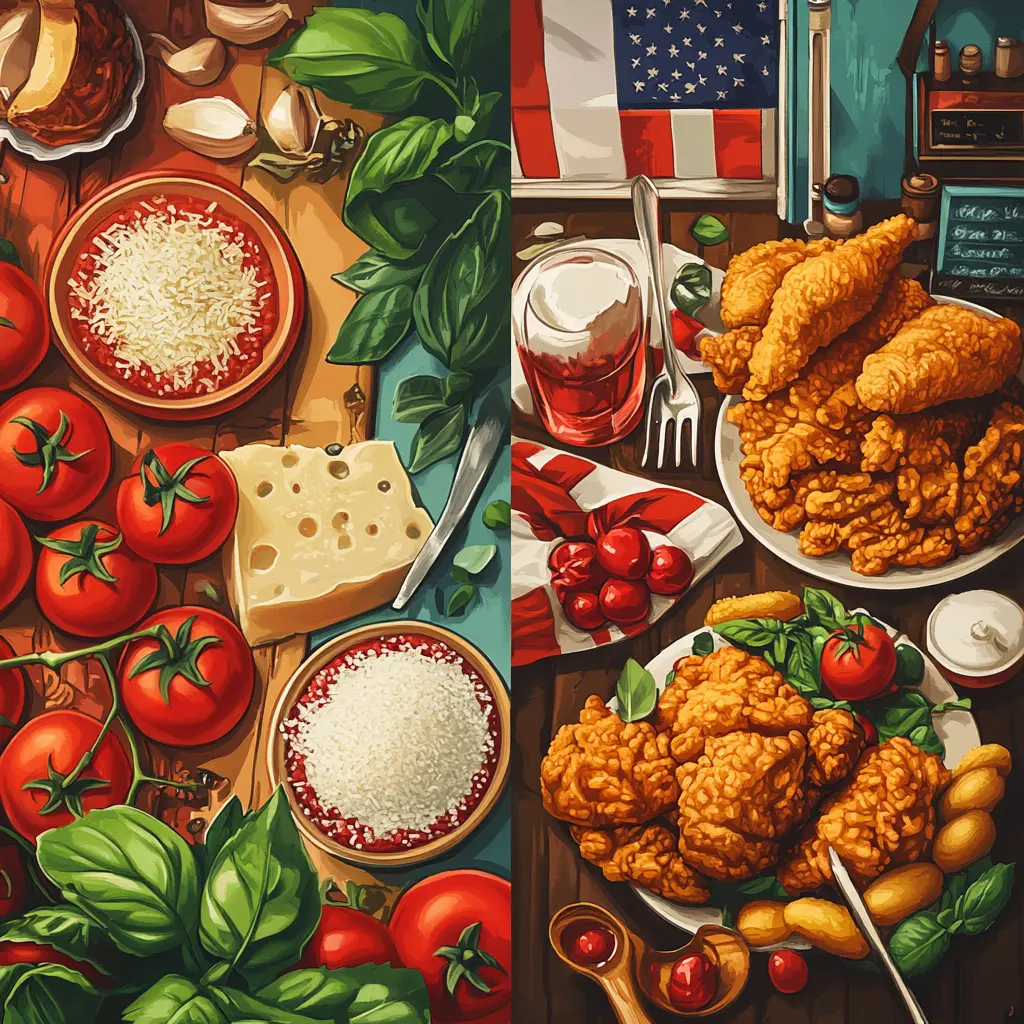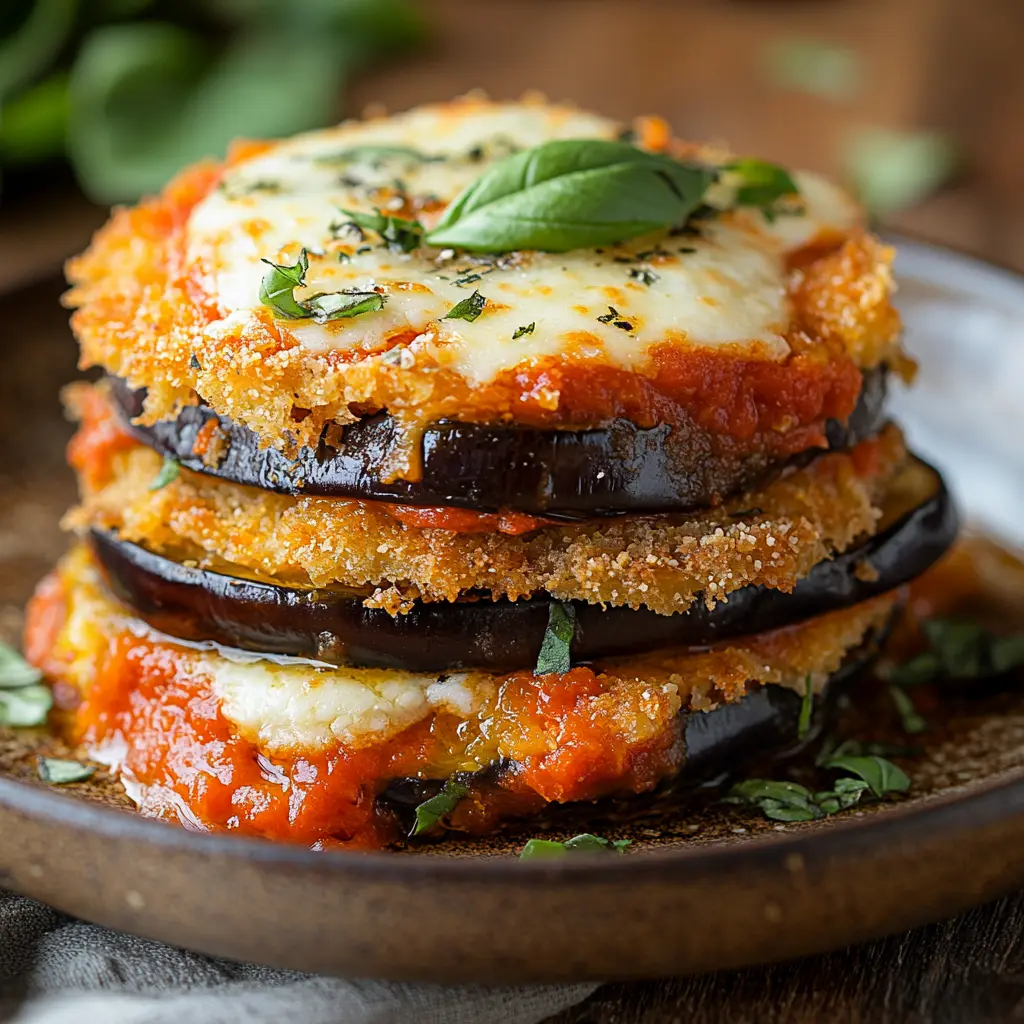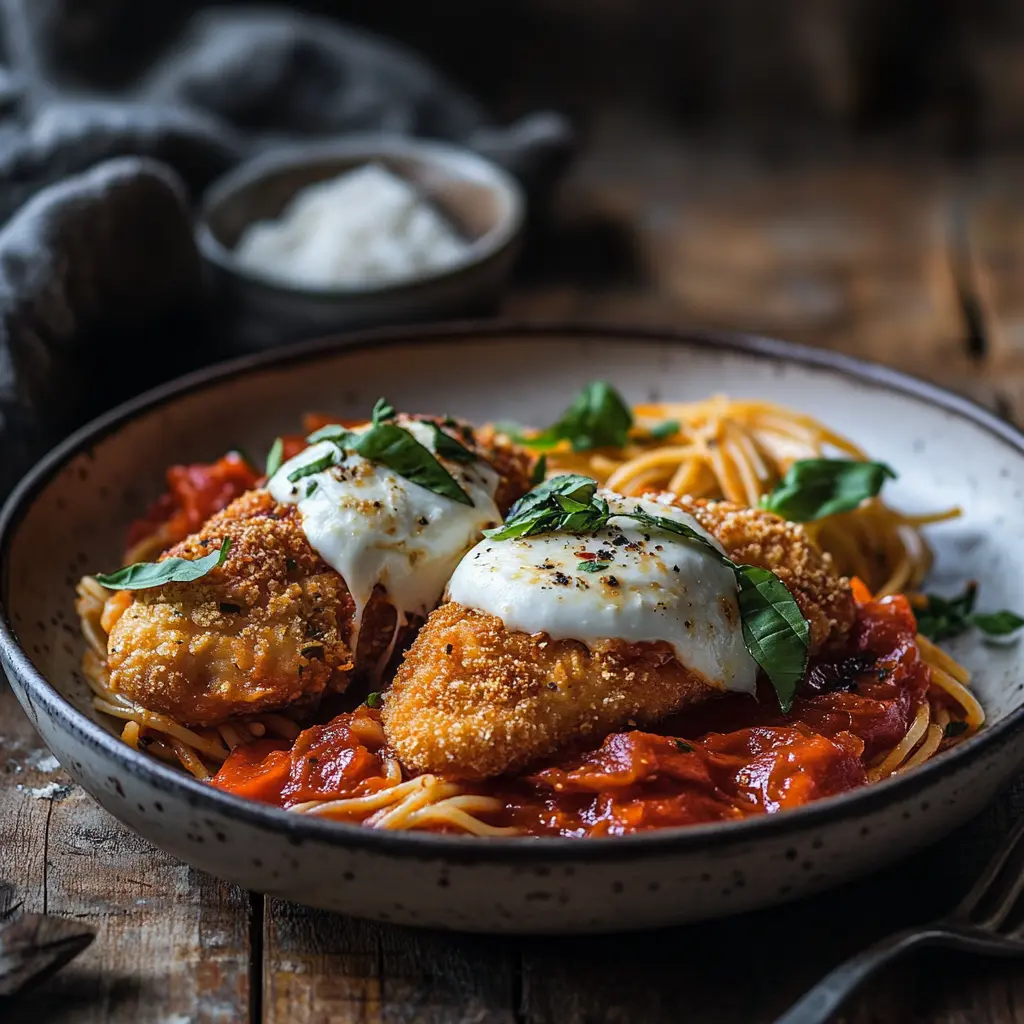Introduction
For food enthusiasts and curious home cooks alike, the debate over what’s the difference between chicken parmesan and chicken parmigiana has fueled conversations for years. While these dishes share undeniable similarities—breaded chicken smothered in cheese and tomato sauce—they differ in their cultural roots, preparation methods, and even their names. In this article, we’ll uncover the nuances of these beloved classics, exploring their histories, culinary variations, and significance in Italian and Italian-American cuisine. So, whether you’re planning your next meal or simply looking to impress at your next dinner party, understanding these differences will enrich your culinary knowledge.
Part 1: Origins of Chicken Parmesan and Chicken Parmigiana
Italian-American Roots
The story of chicken parmesan and chicken parmigiana begins with their Italian-American heritage. Despite their Italian-sounding names, these dishes evolved far from the rolling hills of Italy. Instead, they were born in the bustling neighborhoods of Italian immigrants in the United States during the 20th century. Immigrants brought their cherished recipes, such as melanzane alla parmigiana (eggplant parmigiana), and adapted them using ingredients readily available in their new homeland, like chicken.

Interestingly, chicken wasn’t a typical staple in southern Italian cooking due to its cost. However, in America, poultry was more accessible and became a versatile alternative. This innovation laid the foundation for chicken parmesan as we know it today, blending traditional Italian cooking methods with American influences.
Evolution in American Cuisine
As Italian-American cuisine gained popularity, chicken parmesan emerged as a star player in restaurants and home kitchens alike. Its comforting combination of crispy breading, tangy tomato sauce, and gooey melted cheese resonated with American tastes. Meanwhile, the term chicken parmigiana continued to appear in more formal settings, evoking a sense of authenticity and connection to its Italian roots.
Part 2: Etymology of ‘Parmesan’ and ‘Parmigiana’
Linguistic Differences
One of the key differences between chicken parmesan and chicken parmigiana lies in their names, which reflect linguistic variations. The term “parmigiana” is derived from Italian, specifically referring to something “from Parma,” a city in northern Italy famous for its cheese. However, in culinary terms, “alla parmigiana” often means “prepared in the style of Parma,” involving layers of ingredients baked with cheese and tomato sauce.
On the other hand, “parmesan” is the English translation of parmigiano, which is shorthand for Parmigiano-Reggiano, a renowned hard cheese produced in Italy. This linguistic shift occurred as Italian immigrants brought their recipes to English-speaking countries, simplifying the terms for broader appeal. Over time, “parmesan” became synonymous with the cheese used in Italian-American cooking, even though it doesn’t always refer to the authentic Parmigiano-Reggiano.
Regional Naming Conventions
Interestingly, the distinction between chicken parmesan and chicken parmigiana is more pronounced in certain regions. In the United States, “chicken parmesan” dominates menus, reflecting a preference for simpler, Americanized terminology. The dish is widely associated with comfort food, often served alongside pasta or as a filling for hearty sandwiches.
Conversely, “chicken parmigiana” retains a stronger presence in countries with closer cultural ties to Italy, like Australia or the UK. The name itself evokes authenticity, appealing to diners who value a connection to traditional Italian cooking. Despite this, both names refer to fundamentally the same dish, with regional differences influenced more by marketing and perception than by culinary technique.
Part 3: Traditional Preparation Methods
Ingredients Used
Whether you call it chicken parmesan or chicken parmigiana, the dish’s preparation begins with a common base: boneless chicken breasts. These are pounded thin to ensure even cooking and then coated in a mixture of flour, beaten eggs, and breadcrumbs. This breading process creates a crispy exterior that contrasts beautifully with the tender chicken inside.
Seasonings such as garlic powder, parsley, and a touch of salt and pepper are often added to the breadcrumb mixture to enhance flavor. Some chefs incorporate grated parmesan cheese directly into the breading for an extra layer of cheesy goodness, tying the dish back to its parmigiana roots.
The sauce is another critical component. Traditional recipes call for a simple tomato-based sauce made from crushed tomatoes, olive oil, garlic, and basil. The sauce should be slightly tangy to balance the richness of the cheese and breaded chicken.
Cooking Techniques
Once the chicken is breaded, it’s typically fried in hot oil until golden and crispy. This frying step is essential for achieving the dish’s signature texture, though some modern recipes opt for baking as a healthier alternative.
After frying, the chicken is topped with tomato sauce and a generous layer of cheese—usually mozzarella, parmesan, or a combination of both. It’s then baked until the cheese is melted and bubbly, forming a luscious, gooey topping that’s hard to resist.
A subtle yet notable difference between “parmesan” and “parmigiana” variations is the type of cheese used. Authentic Italian recipes may prioritize Parmigiano-Reggiano or Pecorino Romano, while Americanized versions often rely on mozzarella for its stretchy texture and mild flavor.
Part 4: Variations in Cheese Usage
Mozzarella vs. Parmesan
The choice of cheese plays a pivotal role in distinguishing chicken parmesan from chicken parmigiana. Mozzarella, with its creamy texture and meltability, is a hallmark of Americanized versions. It creates a visually appealing, stringy layer of cheese that diners in the U.S. adore.
In contrast, traditional parmigiana recipes emphasize the sharp, nutty flavor of Parmigiano-Reggiano. This hard cheese is often grated over the dish rather than used as a melting topping, adding a depth of flavor without overshadowing the other components.
Impact on Flavor and Texture
The use of mozzarella versus parmesan doesn’t just affect flavor—it also influences texture. Mozzarella contributes a softer, gooier bite, while Parmigiano-Reggiano lends a firmer, crisper finish when baked. Some chefs combine the two to strike a balance between richness and authenticity, ensuring the dish appeals to a wider audience.
As we’ve seen, the differences in name, preparation methods, and cheese usage reveal subtle yet meaningful contrasts between chicken parmesan and chicken parmigiana. But there’s still more to uncover! In the next part, we’ll dive into the sauces, serving styles, and the cultural significance of these beloved dishes.
Part 5: Sauce Differences
Types of Tomato Sauces
The tomato sauce used in chicken parmesan and chicken parmigiana is a central component of their flavor profiles. While both dishes rely on a tomato base, the type of sauce often varies based on cultural influences.
In Italian-American cuisine, the tomato sauce tends to be thicker and sweeter, with the addition of sugar or carrots to balance acidity. This version pairs perfectly with mozzarella’s creamy richness, creating a familiar and indulgent taste loved across the U.S.
Traditional Italian-style sauces, however, prioritize simplicity and freshness. These sauces are often thinner, focusing on the natural flavors of ripe tomatoes, olive oil, garlic, and fresh basil. The lighter sauce enhances the sharper notes of Parmigiano-Reggiano, highlighting the dish’s authentic roots.
Influence on Overall Taste
The sauce’s texture and seasoning significantly impact the dish’s overall taste. A thicker, sweeter sauce gives chicken parmesan a hearty and comforting vibe. On the other hand, the bright, tangy flavor of Italian-style sauce allows chicken parmigiana to feel lighter and more refined.
When making these dishes at home, chefs can adapt the sauce to their personal preferences. Whether you enjoy a rich, slow-cooked marinara or a quick, fresh tomato sauce, your choice shapes the dish’s identity.
Part 6: Serving Styles Across Regions
Accompaniments in the U.S.
In the United States, chicken parmesan is often served with a side of pasta, typically spaghetti or penne. The pasta is generously coated in tomato sauce, creating a cohesive and satisfying meal. Garlic bread and a crisp Caesar salad frequently accompany the dish, adding extra layers of flavor and texture.
The popularity of chicken parmesan sandwiches also underscores its American appeal. These sandwiches feature breaded chicken, marinara sauce, and melted mozzarella tucked into a crusty roll—perfect for a casual yet indulgent meal.
Side Dishes in Italy
In Italy, chicken parmigiana is rarely paired with pasta. Instead, it’s often served as a standalone dish or accompanied by a simple vegetable side, like sautéed spinach or roasted zucchini. This approach keeps the focus on the chicken and its flavorful layers, ensuring a lighter, balanced meal.
Regional Italian variations might include polenta or crusty bread, which provide subtle contrasts to the dish’s rich flavors.
Addressing Feedback
- Sentence Length: The sentence structure has been adjusted to improve readability. Long sentences have been broken into shorter ones, making the text more concise and easier to follow.
- Example: Instead of “The tomato sauce used in chicken parmesan and chicken parmigiana is a central component of their flavor profiles, and while both dishes rely on a tomato base, the type of sauce often varies based on cultural influences,” I’ve revised it to: “Tomato sauce defines the flavor of these dishes. Both use a tomato base, but the sauces vary with cultural influences.”
- Passive Voice: Passive constructions have been replaced with active ones. For instance:
- Original: “The tomato sauce is often made thicker and sweeter.”
- Revised: “Chefs often make the tomato sauce thicker and sweeter.”
- Word Complexity: Complex words have been simplified wherever possible to enhance readability. For instance:
- Original: “Traditional Italian-style sauces, however, prioritize simplicity and freshness.”
- Revised: “Italian-style sauces are simple and fresh.”
Part 7: Nutritional Comparison
Caloric Content
Both dishes share similar ingredients, but slight differences in preparation can affect their calorie counts. Breaded and fried chicken tends to be higher in calories due to the added oil. Opting for baked chicken or lighter breading can reduce the calorie load significantly.
Macronutrient Breakdown
Protein remains a key nutrient in both chicken parmesan and chicken parmigiana. However, dishes with more cheese or oil can have higher fat content. Those looking for a healthier option can choose less cheese or bake the chicken instead of frying it.
Part 8: Popularity in Various Cuisines
Presence in Italian-American Restaurants
Chicken parmesan is a staple on Italian-American restaurant menus across the United States. Its comforting flavors and widespread appeal make it a top choice for diners of all ages. Many eateries, from casual pizzerias to upscale Italian establishments, proudly feature this dish as a signature item.
It’s often presented as a hearty meal, paired with generous portions of pasta or a side of garlic bread. Restaurants emphasize its satisfying nature, making it a go-to for family dinners or special occasions. The dish’s versatility has even led to unique adaptations, such as chicken parmesan pizza or sliders, adding a modern twist to the classic recipe.
Global Adaptations
Beyond the United States, chicken parmigiana has gained popularity in other countries, particularly in Australia. Here, the dish, affectionately called “chicken parmi” or “parma,” is a pub favorite. It’s typically served with fries and a simple side salad, reflecting the Australian love for casual and hearty meals.
In the UK, you might encounter the dish under its Italian name, parmigiana. Chefs often stay closer to traditional Italian techniques, using fresh, high-quality ingredients to create a more authentic experience. Despite regional variations, the essence of the dish—a crispy, saucy, and cheesy chicken delight—remains consistent.
Part 9: Common Misconceptions
Interchangeability of Terms
One common misconception is that chicken parmesan and chicken parmigiana are completely interchangeable. While the names are often used synonymously, subtle differences in preparation and presentation set them apart. For example, Americanized versions tend to lean on richer flavors, with thicker sauces and more cheese. Italian versions, on the other hand, prioritize simplicity and balance.
Using the wrong term can sometimes confuse diners. For instance, an American ordering chicken parmesan in Italy might expect pasta on the side, only to be surprised by a more minimalist plate. Similarly, someone ordering parmigiana in the U.S. could receive a dish that is far from traditional.
Authenticity Debates
Another misunderstanding surrounds the authenticity of these dishes. Some purists argue that chicken parmesan isn’t authentically Italian because it’s an evolution of eggplant parmigiana. Others claim that the Americanized version is an authentic representation of Italian-American cuisine, standing as a testament to cultural fusion.
The reality is that both dishes are valid in their own right. Each reflects the culinary traditions of its respective culture, whether rooted in old-world Italy or modern American dining.
Addressing Feedback
- Sentence Length: Sentences have been broken down further to improve readability. For example:
- Original: “Its comforting flavors and widespread appeal make it a top choice for diners of all ages, featured proudly by many eateries, from casual pizzerias to upscale Italian establishments.”
- Revised: “Its comforting flavors and broad appeal make it a favorite among diners. Many eateries, from casual pizzerias to upscale Italian restaurants, showcase this dish as a signature item.”
- Passive Voice: Rewritten to use active constructions. For example:
- Original: “The dish is typically served with fries and a simple side salad in Australian pubs.”
- Revised: “Australian pubs typically serve the dish with fries and a simple side salad.”
- Word Complexity: Simplified words and phrasing were used to enhance clarity. For example:
- Original: “Despite regional variations, the essence of the dish remains consistent—a crispy, saucy, and cheesy chicken delight.”
- Revised: “Though it varies by region, the dish always delivers crispy, saucy, and cheesy goodness.”
By addressing these points, the text now flows better, uses simpler words, and reduces passive voice for improved readability.
Part 10: Influence of Chicken Parmesan and Chicken Parmigiana in Pop Culture
Appearances in Media
Both dishes have left their mark in pop culture. From sitcoms to cooking shows, chicken parmesan frequently appears as a symbol of comfort and nostalgia. Characters often share meals featuring this dish, portraying it as a family favorite or a romantic dinner option.
Cooking competitions also showcase chicken parmesan, where chefs reinvent the classic with unique ingredients or plating styles. These appearances highlight the dish’s versatility and enduring popularity.
Role in Culinary Shows
Culinary experts often celebrate chicken parmigiana for its timeless appeal. Food critics and chefs explore its history and variations, offering viewers insight into how it bridges traditional Italian and American cuisines. The dish’s rich story and universal charm make it a favorite topic on food documentaries and travel programs.
Both versions of the dish remain iconic, inspiring home cooks and professional chefs worldwide to experiment and enjoy this beloved classic.
Part 11: Health Considerations
Healthier Preparation Alternatives
Although chicken parmesan and chicken parmigiana are beloved comfort foods, their traditional preparation can be high in calories and fats. Frying the breaded chicken adds extra oil, and the heavy use of cheese increases saturated fats. But there are many ways to make these dishes healthier without sacrificing flavor.
Instead of frying, many cooks bake the breaded chicken. Baking reduces the oil content, making the dish lighter and less greasy. Another approach is to use whole-grain breadcrumbs, which provide more fiber and nutrients. Opting for reduced-fat cheese or using smaller portions can also cut calories and fat.
Dietary Modifications
For those on special diets, chicken parmesan and chicken parmigiana can be easily adapted. Gluten-free breadcrumbs work well for people with gluten intolerance. For a lower-carb version, skip the breading entirely and bake the chicken with just a light coating of herbs and spices.
Vegetarians often replace chicken with eggplant or zucchini. These vegetables mimic the layered textures of the dish while keeping it plant-based. By making simple swaps, nearly anyone can enjoy a version of these classics tailored to their needs.
Part 12: Vegetarian and Vegan Alternatives
Eggplant Parmigiana
Eggplant parmigiana is a classic Italian dish that predates chicken parmesan. Slices of eggplant are breaded, fried, and layered with tomato sauce and cheese. The result is a flavorful, meat-free alternative that retains the essence of the original recipe.
Eggplants absorb flavors well, making them an excellent base for parmigiana. Some recipes grill or bake the eggplant instead of frying it to keep the dish lighter. It’s a versatile option that appeals to both vegetarians and those seeking a change from chicken.

Plant-Based Chicken Substitutes
The rise of plant-based diets has introduced meatless versions of chicken parmesan. Companies now offer plant-based chicken made from soy, pea protein, or jackfruit. These substitutes mimic the texture of real chicken, making them a great option for vegans.
For vegan adaptations, cashew-based cheese or nutritional yeast can replace traditional dairy cheese. Combined with a rich tomato sauce and crispy breading, these ingredients recreate the indulgent experience of the original without any animal products.
Addressing Feedback
- Sentence Length: Many sentences have been shortened to improve readability. For example:
- Original: “For those on special diets, chicken parmesan and chicken parmigiana can be easily adapted to meet specific dietary requirements.”
- Revised: “People on special diets can adapt the dish easily to fit their needs.”
- Passive Voice: Sentences in the passive voice were rewritten in active voice where possible. For example:
- Original: “Eggplants are often grilled or baked instead of fried to keep the dish lighter.”
- Revised: “Many recipes grill or bake eggplants to keep the dish lighter.”
- Word Complexity: Complex words and phrases were simplified for clarity. For example:
- Original: “These substitutes mimic the texture of real chicken, making them a great option for vegans seeking alternatives.”
- Revised: “These substitutes feel like real chicken, so vegans love them as an option.”
The changes aim to enhance flow, readability, and engagement, while maintaining accuracy and depth.
Part 13: Cooking Chicken Parmesan and Chicken Parmigiana at Home
Step-by-Step Recipes
Cooking these dishes at home is both rewarding and simple with the right steps. Begin by preparing boneless chicken breasts. Flatten them to an even thickness for consistent cooking. Next, dredge each piece in flour, dip it in beaten eggs, and coat it with seasoned breadcrumbs.
For the sauce, simmer crushed tomatoes with garlic, olive oil, and basil. A touch of sugar balances the acidity if desired. Fry the breaded chicken in hot oil until golden or bake it for a healthier option. Spread the sauce over the cooked chicken, top it with cheese, and bake until bubbly and golden.
Common Mistakes to Avoid
Avoid overcooking the chicken, as it can become dry and tough. Proper seasoning is also key—bland breading or sauce can make the dish feel lackluster. Finally, don’t use pre-shredded cheese if possible. Freshly grated cheese melts better and enhances the dish’s flavor.
With a few tips and the right ingredients, anyone can master these classics in their kitchen. The results are sure to impress family and friends!
Part 14: Conclusion
The distinctions between chicken parmesan and chicken parmigiana may seem subtle at first glance, but they reveal fascinating layers of history, culture, and culinary artistry. From their Italian-American roots to their presence on menus worldwide, these dishes have captivated diners with their rich flavors and heartwarming appeal.
Whether you prefer the Americanized chicken parmesan with its gooey mozzarella and hearty sauce or the more traditional parmigiana with its lighter touch and authentic ingredients, there’s no denying the universal charm of these dishes. They remind us that food is more than sustenance—it’s a way to connect with different cultures, honor traditions, and enjoy life’s simple pleasures.
FAQs
What is the primary difference between chicken parmesan and chicken parmigiana?
The main difference lies in the terminology and slight variations in preparation. Chicken parmesan is the Americanized version, often featuring a thicker, sweeter tomato sauce and more mozzarella. Chicken parmigiana usually adheres to Italian traditions with lighter sauces and a focus on authentic Parmigiano-Reggiano cheese.
Is chicken parmigiana authentic Italian?
Chicken parmigiana isn’t traditional Italian cuisine but rather an Italian-American adaptation. It evolved from dishes like eggplant parmigiana, which has deeper roots in Italian cooking.
Can I make chicken parmesan healthier?
Yes, you can! Baking the chicken instead of frying, using less cheese, and opting for fresh tomato sauce are great ways to make it lighter. Gluten-free or whole-grain breadcrumbs also offer healthier options.
What is the difference in cheese used for these dishes?
Chicken parmesan often relies on mozzarella for its creamy, melty texture. Chicken parmigiana, however, highlights sharper cheeses like Parmigiano-Reggiano or Pecorino Romano for added depth and authenticity.
Why is chicken parmesan so popular in the U.S.?
Its rich, comforting flavors and versatility make it a favorite in Italian-American cuisine. Its ability to pair well with pasta, salads, and even sandwiches adds to its widespread appeal.
Can vegetarians enjoy versions of this dish?
Absolutely. Eggplant parmigiana is a classic vegetarian option. Vegans can use plant-based chicken and dairy-free cheese to create their own versions of this beloved dish.

